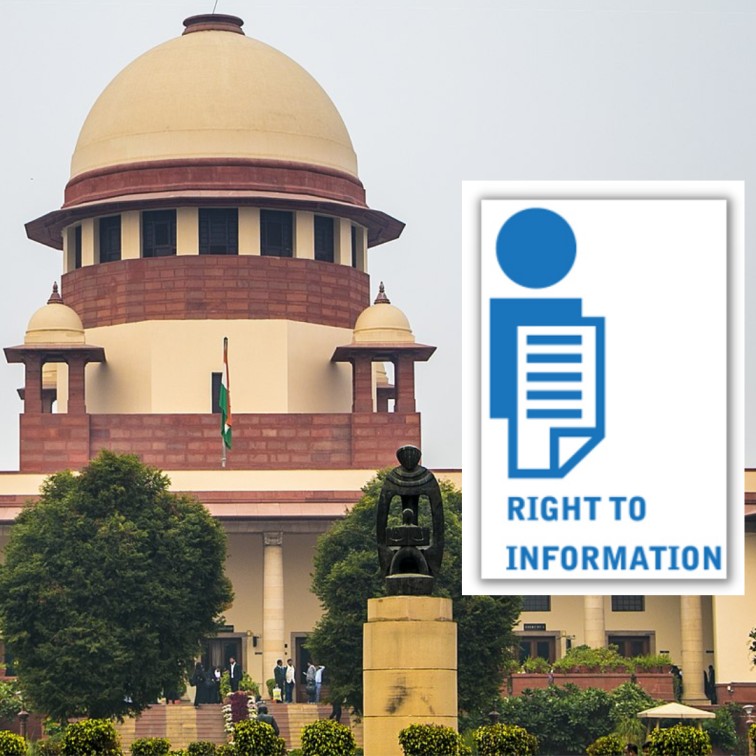
Image Credits: Wikipedia, NIC Guwahati
Supreme Court Launches Online RTI Portal, Here's How You Can Use It
Writer: Jayali Wavhal
She writes about gender issues, human interest, and environment.
India, 29 Nov 2022 9:23 AM GMT
Editor : Shiva Chaudhary |
A post-graduate in Journalism and Mass Communication with relevant skills, specialising in content editing & writing. I believe in the precise dissemination of information based on facts to the public.
Creatives : Jayali Wavhal
She writes about gender issues, human interest, and environment.
The web portal will facilitate only those who want to secure information from the Supreme Court; any other information from public authorities will have to be sought from respective government portals.
Making it easier for citizens to access information from the Supreme Court and file applications under the Right To Information (RTI) Act, the Supreme Court has launched an online RTI portal on November 24. Earlier, RTI applications could only be filed by post, making the mechanism slow amid the wide use of technology and digitalisation.
The online portal, which can be accessed at the website, will help streamline the apex court's responses under the RTI Act.
What Is The RTI Act?
The Right To Information Act of 2005 allows citizens to access and secure information under the control of public authorities. The act, which replaced the Freedom of Information Act 2002, promotes transparency between the governing authorities and the common public and also makes the authorities more accountable.
True to the democratic nature of the country, the act empowers citizens and helps them raise concerns against any lacunae in the functioning of the authority. Any application filed under the RTI Act needs to be responded to by the authorities within 30 days, and in cases of life and death, the response time is mandated to be a maximum of 48 hours.
A prime example of how the RTI Act helps citizens is the uncovering of the Adarsh Society Scam by RTI activists Simpreet Singh and Yogacharya Anandji. Initially meant to be a six-storey residential building for the widows of Kargil war heroes, the building – a landmark in Mumbai's posh residential area of Colaba – was turned into a 31-storey complex called Adarsh Society. Several politicians, bureaucrats and army officers moved into the building as its residents, nullifying the initial plan.
However, an RTI application by the two activists revealed that the piece of land the building was constructed on belonged to the Ministry of Defence and not the Maharashtra state government. The big revelation led to the resignation of the then chief minister Ashok Chavan, reports Business Standard.
Online Portal Launched
During the launch of the online portal, the Chief Justice of India, DY Chandrachud, said, "Before we start with the mentioning (of cases), I wanted to say that the RTI portal is ready. It will start working in 15 minutes. In case there are some problems, please bear with us. If there is some problem, get back to me. I will be more than happy to look into it".
The move to launch an online portal comes following several public interest litigations (PIL) that were filed in the Supreme Court. The PILs pointed out that while citizens could file petitions online, they still needed an online mechanism to file RTIs too.
The web portal will facilitate only those who want to secure information from the Supreme Court; any other information from public authorities will have to be sought from respective government portals, reported The Indian Express.
How To Use The RTI Portal?
Through the RTI portal, citizens can now file RTI applications, make payments for fees, file appeals, and pay copying charges, all under the RTI Act. The steps to file an RTI application online are the same as earlier, with a few online tweaks.
The applicant will have to sign up or sign in to the portal before they can file an RTI application. To validate their account, the applicant will have to submit an address proof which will be recorded in the system. Once the application is submitted, on the next page, the applicant must fill in all the necessary information as instructed and attach the required documents as a PDF document within the specified file size.
For the payment, the applicant can pay the fee of ₹10 through internet banking, credit/debit cards from Mastercard or Visa, or UPI. Applicants who are Below Poverty Line (BPL) won't have to pay the application fee as they are exempted from it under the RTI rules of 2012. However, such applicants will have to attach and upload a copy of their government-issued BPL certificate.
Also Read: CJI Chandrachud Asks Visually-Challenged Lawyer To Help Make Courts More Disabled-Friendly
 All section
All section














